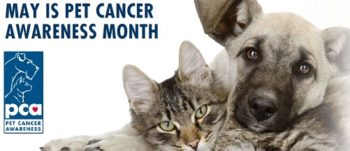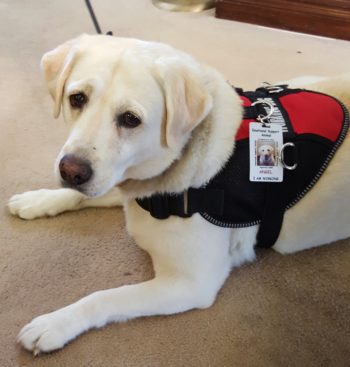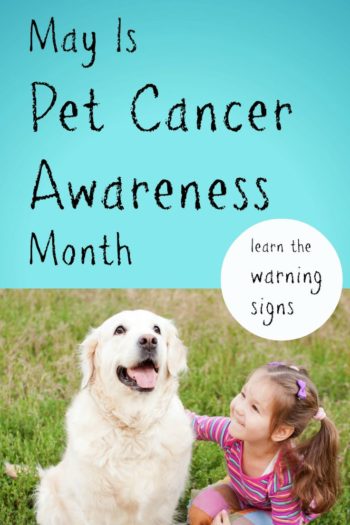 LUMPS AND BUMPS IN DOGS AND CATS
LUMPS AND BUMPS IN DOGS AND CATS
Hello everyone and welcome to another FACTUAL FRIDAY. As you know, May is SKIN CANCER AWARENESS MONTH. But, you may not know that May also is PET CANCER AWARENESS MONTH.
Now, truthfully, some sources say that November is Pet Cancer Awareness Month. But, just to cover our bases, we’ll go ahead and discuss this topic now as cancer in cats and dogs is very common and deserving of discussion.
In fact, last fall my beautiful Therapy Dog, Angel, had her first experience with cancer. I actually was giving her a tummy rub when I felt a funny rather spongy small spot just under her skin. It felt different from the usual “fatty” lumps – known as benign lipomas — that she has had over the years. So, of course, I took her right to the vet.
Our wonderful Dr. Sarah examined her and agreed we should do a biopsy. When the lab results came back, it was confirmed the spongy “spot” was a mast cell tumor, which is a form of canine skin cancer.
Fortunately, the tumor was small, early stage and non-aggressive, so Angel underwent surgery to have it removed. And, because the tumor was located on an area of her body where the surgeon could get good margins – in other words, could remove enough surrounding tissue to make sure the entire tumor was removed – Angel didn’t have to undergo any further treatment.
Now, I learned that mast cell cancer tumors are quite common in dogs and cats. In fact, in dogs these tumors are the most common type of skin cancer, which begin in the mast cells of the immune system and can develop anywhere on the body.
In cats, mast cell tumors typically occur on the skin around the head or neck. And, luckily for felines, only about ten percent of these tumors are cancerous.
But, our furry friends also run a risk for cancers other than mast cell tumors. So, let’s list just a few of the more common cancers for both our beloved dogs and cats.
DOGS AND CANCERS:
1) MELANOMA. Another skin cancer, melanoma can affect dogs of all breeds and colors. Most of these tumors occur on the mouth or on the mucous membranes. Dogs with darker pigmented gums and tongues are at a greater risk. Yet, about ten percent of the time, this cancer also occurs on parts of the canine body that are covered by hair.
2) SQUAMOUS CELL. Similar to humans, dogs also develop squamous cell skin cancer. It’s often caused by sun exposure, but also appears to be linked to the papilloma virus.
3) OSTEOSARCOMA. This is the most common primary bone cancer in dogs. It occurs most frequently in the limbs of large and giant breeds of dogs.
4) MAMMARY GLAND CARCINOMA. Also referred to as breast cancer, unspayed female dogs run the greatest risk for this cancer due to hormonal influences on the mammary tissues.
5) LYMPHOMA. This blood borne cancer affects our dog’s white blood cells, which are called lymphocytes. While common, this cancer remains highly treatable in dogs.
CATS AND CANCERS:
1) LYMPHOMA. Once again, this cancer in cats affects the white blood cells called lymphocytes. It’s very common in cats, especially those infected with feline leukemia virus — FeLV — or feline immunodeficiency virus – FIV. It’s also more common in male cats than female.
2) MAMMORY GLAND CARCINOMA. Similar to canines, this cancer affects the breast tissue and is more common in older, unspayed females due to hormonal influences. It’s also the third most common cancer in domestic cats.
3) BASEL CELL. This type of skin cancer can occur as a single bump or in clusters. These tumors can occur anywhere on a cat, but are most commonly found on the face, back and upper chest areas.
4) SQUAMOUS CELL. These tumors generally show up as non-healing wounds. They are most common on the ears, lips, nose, mouth and eyelids of cats. In white cats, these tumors can be aggravated by sunlight and cats with light pigmented or pink skin have the greatest risk.
5) FIBROSARCOMA. This is an aggressive type of cancer that begins in the fibrous connective tissue of cats. Similar to lymphoma, this cancer also is more common in cats with FeLV or FIV and typically occurs as a single mass on a cat’s head, legs or in the mouth. 
Now, I know what you’re thinking. Why do we have to discuss these depressing things? After all, we just want to love our pets and enjoy our time together.
But, a big part of loving our pets is to take care of them and protect them from harm. And, to do that we need to understand the health risks that come with our pets and the responsibility that comes with pet ownership.
While I hated to discover that Angel had a malignant tumor, I was so grateful I discovered it in time to treat it successfully. And, of course, now I inspect her tummy and her skin every day for new lumps and bumps. Because, I know from my own skin cancer experience, cancer can return. I just want to do everything I can – for as long as I can – to protect Angel and ensure we have as many happy and healthy years together as possible.
And, to do this we simply have to apply the same diligence and common sense with our pets as we do with ourselves and our other family members.
- Know what your pet’s risks are for developing certain cancers.
- Pay attention to any change in the appearance of their skin.
- Make note of any new lump or bump and report it to your vet.
- Inspect and groom your pet regularly.
- Design a wellness program for your pet and schedule regular appointments with your vet.
If you’re like me, you probably can’t imagine life without a pet. They bring so much comfort and companionship into our lives. Their presence helps ground us, relax us and de-stress us. They teach us the true meaning and importance of unconditional love, lasting loyalty and steadfast patience.
So, enjoy your four-legged furry friends. Be thankful for every moment you have together. And, honor PET CANCER AWARENESS MONTH by scheduling a wellness appointment for Fido or Fluffy with your favorite vet today!
Once again, thanks for joining me everyone. Until next time, stay in GOOD HEALTH and . . .
TAKE THE COURSE AND TAKE CHARGE!



Leave a Comment